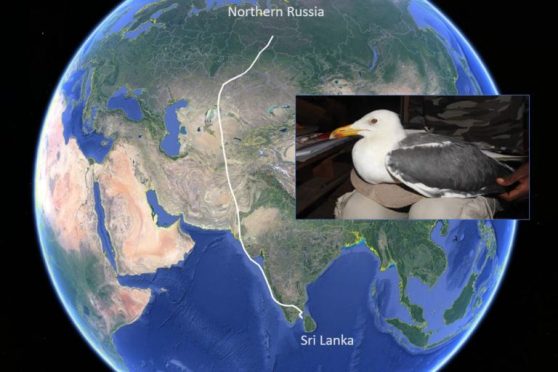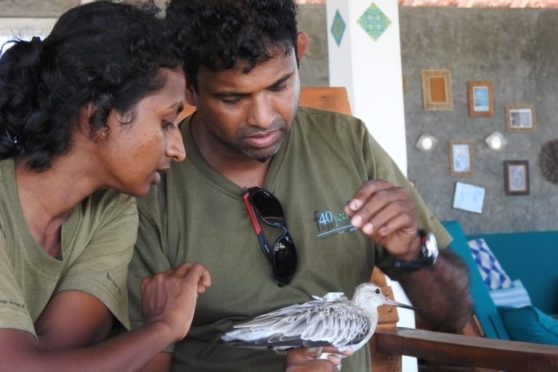The journey back
Sri Lanka tagging program traces little-known paths of migratory birds
By Malaka Rodrigo
MANNAR — Born in the frozen Arctic tundra, a population of Heuglin’s gull (Larus fuscus heuglini) heads to tropical Sri Lanka every year during the harsh Northern Hemisphere winter.
On the Indian Ocean island, they hunt for fish and recuperate from their long flight while also building up their energy reserves for the journey back. This year, as they prepared for the return with the onset of spring in their Siberian home, one of the gulls never saw the trap set up to capture it. Luckily for this gull, the trap wasn’t set by hunters, but by scientists studying migratory patterns of birds.
After carefully retrieving the Heuglin’s gull from the trap, they measured it and attached a GPS transponder to its back. The bird appeared a little annoyed initially but soon paid no attention to the gadget as it was clearly no threat. And then it took off, the very next day, on the long flight back to its breeding ground.
Tracking birds in flight
“We tagged the gull on April 4, and it took 60 days to complete its journey back to the Siberian region in northern Russia at the rim of the Arctic,” said Gayomini Panagoda, a PhD candidate at the University of Colombo. “The bird could have flown over 7,000 kilometres [4,350 miles]. We previously thought they took the long flight during the day, but satellite data indicated they continue flying even during the night.”
The Heuglin gull was tagged as part of a groundbreaking project in Sri Lanka to monitor the movements of migratory birds using satellite tags. The project is a collaboration between the Field Ornithology Group of Sri Lanka (FOGSL), based at the University of Colombo, and the Chinese Academy of Sciences (CAS) and the Wetlands International, with support from several local sponsors. CAS provided the satellite tags and the technology to FOGSL, which selected the region of Mannar in northwestern Sri Lanka, a strategic entry point for many of the more than 200 migratory bird species that overwinter here, to tag the birds.
FOGSL, which is also the Sri Lanka affiliate of BirdLife International, initiated the National Bird Ringing Program in 2004 in collaboration with the Department of Wildlife Conservation (DWC).
The earlier tracking tags they used were essentially data loggers that had to be physically retrieved from the animal to get the data. The new satellite tags, however, are state-of-the-art technology that give real-time data and have revolutionized the study of bird movements.
Realizing the effectiveness of satellite tags, FOGSL wanted to use them in the National Bird Ringing Programme, but the technology proved too expensive. “It was not easy to find a technical partner, so we ended up writing to many organizations seeking assistance for several years,” said Sampath Seneviratne, a research scientist at the University of Colombo and the brains behind the satellite-tagging project.

Popular routes
The Central Asian Flyway (CAF) is the name given to the corridor used by migratory birds flying between the Arctic and the Indian Ocean. Sri Lanka is the last landmass south on this route, and hence an important destination for many migratory birds.
But the boundaries of the CAF are only broadly defined and poorly understood, so researchers want to use this tagging opportunity to gain greater understanding.
“To achieve this, we aim at species representing both the western and eastern arms of the CAF, as well as visiting species from both the high Arctic and temperate latitudes, capturing the full spectrum of migration systems within the flyway,” Seneviratne told Mongabay.
The researchers chose to tag a Heuglin’s gull because the species breeds in northern Russia’s Arctic region, a starting point of the CAF, Seneviratne said.
Also known as the Siberian gull, it’s a large seabird that’s a subspecies of the lesser black-backed gull, Larus fuscus, and is often confused with the herring gull, Larus argentatus. This makes the taxonomy of Heuglin’s gull a bit vague, something that this research will hopefully shed some light on, Seneviratne said.
The project’s partner, the Chinese Academy of Sciences, initially provided 35 satellite tags designed for different migratory birds. Other important bird species tagged under the project include the Eurasian wigeon (Mareca penelope), common redshank (Tringa totanus), Eurasian whimbrel (Numenius phaeopus), crab plover (Dromas ardeola), bar-tailed godwit (Limosa lapponica), black-tailed godwit (Limosa limosa) and Caspian tern (Hydroprogne caspia).
Addressing research gaps
Traditional bird migration maps show three main routes that birds use to reach Sri Lanka along the CAF corridor: eastern, western, and via India’s the Andaman Islands.
“These routes are defined based on anecdotal evidence, mostly based on observations rather than facts or founded on research,” said Sarath Kotagama, emeritus professor at the University of Colombo, a pioneer in bird studies in Sri Lanka, and a founder of the National Bird Ringing Programme. “The data we receive through this project will be really useful in defining these flyways.”
The satellite tagging can also shed light on the birds’ movement within Sri Lanka. This would help identify the sites that are critical for the survival of these bird species and can help prioritize conservation actions, Kotagama explained.
The tagging took place mainly in the mudflats of northwestern Sri Lanka’s Mannar district, a strategic entry point to the island used by many migratory bird species. The whole process was labor-intensive, Panagoda said.
“We set up five-day stints for camping and had mist nets on the mudflats during low tide,” she added, explaining, “Within a single day, there are two low-tide cycles, so we set up one cycle during the night from 4 p.m. to 12 midnight, and another in the early hours of the day, around 4 a.m. to about 9 a.m. Then we also had to process the birds by checking their weight, take feather counts and finally put the ring carefully.”
The birds sporting tags sometimes fly out of satellite range, so researchers sometimes had to wait until they flew back into an area with coverage to get the stored data, Panagoda added. The team recently received another 35 satellite tags and is waiting for the next migration season to tag more feathered friends.
-This article was originally featured on news.mongabay.com


